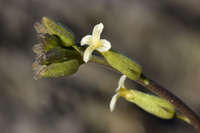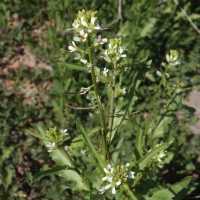Annuals, biennials, or perennials; (caudex woody); not scapose; (usually glaucous), glabrous or pubescent, trichomes usually simple, rarely mixed with fewer, stalked, 2-rayed ones. Stems usually erect or ascending, rarely subdecumbent, unbranched or branched distally, (sometimes inflated). Leaves basal and cauline; petiolate, subsessile, or sessile; basal rosulate or not, petiolate, blade margins entire, dentate, sinuate, lobed, or pinnatifid; cauline petiolate, subsessile, or sessile, blade (base sometimes sagittate or amplexicaul, rarely subauriculate), margins entire, dentate, or lobed. Racemes (corymbose, sometimes with a terminal cluster of sterile flowers from grouping of dark purple flower buds, rarely proximalmost flowers bracteate), elongated in fruit. Fruiting pedicels erect, ascending to divaricate, or reflexed, slender or stout. Flowers: sepals usually erect or ascending, rarely spreading, oblong or ovate to lanceolate, (usually forming urceolate calyx, sometimes keeled), lateral pair saccate or not basally; petals yellow, brown, purple, lavender, white, yellowish green, or, rarely, pinkish, linear to oblanceolate, (often channeled and crisped, rarely neither, equal or abaxial (lower) pair slightly shorter than adaxial (upper) pair, longer than sepals), claw often well-differentiated from blade (sometimes longer and wider than blade, entire); stamens tetradynamous or 3 unequal pairs (rarely subequal); filaments not dilated basally, (usually distinct, sometimes adaxial or both median pairs connate); anthers oblong, (equal or adaxial pair smaller, apex obtuse or apiculate); nectar glands usually confluent, subtending bases of stamens. Fruits sessile, linear, usually smooth, rarely torulose, usually terete, latiseptate, or angustiseptate, rarely 4-angled; valves each with distinct or obscure midvein, glabrous or sparsely pubescent; replum rounded; septum complete, (veinless); ovules 14-60[-210] per ovary; style obsolete or distinct; stigma capitate or not, entire, subentire, or 2-lobed (lobes opposite valves or replum). Seeds uniseriate, usually flattened (plump in C. californicus), usually not winged, rarely margined, oblong, ovoid, or, rarely, subglobose; seed coat not mucilaginous when wetted; cotyledons incumbent or obliquely so, (entire or, rarely, 3-fid). x = 14.
The limits of Caulanthus have not changed for about 60 years following the excellent account by E. B. Payson (1923). R. C. Rollins (1993), however, resurrected Stanfordia mainly based on angustiseptate instead of terete fruits and on the presence of 3-fid cotyledons. The latter character is also present in C. coulteri, a species that Rollins maintained in Caulanthus. As emphasized by Payson and by I. A. Al-Shehbaz (1973), Stanfordia does not merit recognition, a position taken also by O. Appel and Al-Shehbaz (2003). R. E. Buck (1993, 1995) excluded three species of Caulanthus (C. anceps, C. flavescens, C. lasiophyllus) and placed them in the long-abandoned Guillenia. His primary reasoning was that they do not have the urceolate calyx or the crisped and channeled petals. However, C. flavescens has crisped and channeled petals, and sometimes has somewhat urceolate calyces, a feature not found in all species of Caulanthus. Extensive discussion on the maintenance of these three species in Caulanthus was given by Al-Shehbaz and needs not be repeated here. In my opinion, the recognition of Guillenia as distinct from Caulanthus is based on over-emphasis of a few petal characters and, without thorough molecular studies on the entire streptanthoid genera, it is more practical to maintain a more inclusive Caulanthus.














